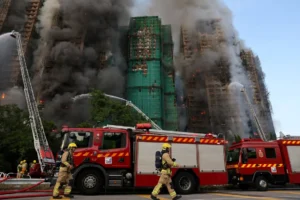
Ethiopia’s ancient volcano erupted unexpectedly, sending ash clouds across thousands of miles to India. While floating safely high above, it disrupted flights and reminded us how connected our world truly is.
Imagine waking up to a sound like thunder, your windows rattling, and the sky turning dark—not from rain, but from ash traveling thousands of kilometers from Africa. That’s exactly what happened when Ethiopia’s Hayli Gubbi volcano suddenly erupted last weekend after sleeping for nearly 10,000 years.
The eruption sent massive clouds of ash almost 15 kilometers into the sky. These clouds didn’t just stay in Ethiopia—they drifted across the Red Sea, passed over Yemen and Oman, and by Monday evening, reached India. Cities like Delhi, Jaipur, Mumbai, and even parts of Punjab saw this volcanic ash floating overhead. It felt surreal to think that dust from an Ethiopian volcano could actually reach our skies, but that’s exactly what modern weather tracking confirmed.
For the people living near the volcano in Ethiopia’s Afar region, life changed overnight. The village of Afdera got covered in thick dust. While thankfully no one died, the real worry is about survival in the coming months. Many families there depend on livestock—goats, sheep, and cattle—for their living. With the ground now buried under ash, these animals have nothing to graze on. The economic loss could devastate entire communities for years.
Now, what does this mean for us in India? The good news first: the ash is floating very high up—between 15,000 to 45,000 feet above ground. That’s way above where we breathe. So our Air Quality Index, which measures pollution at ground level, won’t really change because of this. The weather experts have repeatedly assured us that this event is “mostly safe” for surface air quality.
But here’s what we should still care about. Volcanic ash isn’t like the soft ash from burning paper. It’s made of tiny, sharp particles of rock, minerals, and volcanic glass. These particles are rough, sometimes acidic, and can be harmful if they somehow reach us. Along with ash, the cloud contains sulfur dioxide gas—the same stuff that creates smog.
For most healthy people, if these particles stay high up, there’s minimal risk. But the concern isn’t zero. If you already have asthma, bronchitis, or COPD, even small amounts of volcanic ash can trigger serious breathing problems. The PM2.5 and PM10 particles in volcanic ash can irritate airways, cause inflammation, and make your lungs produce extra mucus. People with sensitive lungs might suddenly need their inhalers more often or even emergency treatment.
The Centers for Disease Control and Prevention warns that short-term exposure to volcanic ash can cause coughing, difficulty breathing, sore throat, itchy red eyes, headaches, and nausea. In some cases, volcanic ash contains crystalline silica, which can cause silicosis—a serious lung disease where your lungs get permanently scarred. Though this usually happens only after years of heavy exposure, it’s still a genuine concern for cleanup workers and those living near active volcanoes.
So what should we do? Stay indoors as much as possible if you notice unusual haze. Keep windows and doors closed. If you must go outside, wear an N95 mask—not just any cloth mask, but a proper N95. Avoid using air conditioners that pull air from outside. If you get ash on your skin or in your eyes, rinse immediately with clean water. And if irritation continues, see a doctor.
The aviation industry took this threat very seriously. Several airlines including IndiGo, Akasa Air, and KLM canceled flights on Monday. Mumbai airport warned passengers about possible disruptions. The reason? Volcanic ash is a jet engine’s worst enemy.
Here’s the scary science: jet engines work at temperatures above 1,500°C. Volcanic ash, which contains lots of silica, melts at around 1,000°C. When ash enters a hot engine, it melts into liquid glass and coats the turbine blades. This can cause engines to stall or shut down completely. If all engines stop, the plane becomes a glider. Pilots then have to shut off engines, glide into colder air hoping the glass layer cracks off, and pray the engines restart. Several aircraft in history have nearly crashed because of volcanic ash. That’s why airlines simply don’t take chances—they reroute or cancel flights.
The DGCA issued advisories asking airlines to avoid affected routes and airports to immediately inspect runways for ash deposits. Even a thin layer of ash on a runway can be dangerous for landing aircraft.
Looking at the bigger picture, this rare eruption reminds us how interconnected our world is. A volcano in northeastern Ethiopia affects air quality discussions in Delhi, disrupts flights in Mumbai, and makes us all suddenly aware of atmospheric science. It shows us that nature doesn’t respect borders—what happens in one corner of the world can have ripples everywhere.
While authorities say the immediate risk to us is low, staying informed and taking basic precautions makes sense. For those with respiratory conditions, this is definitely a time to be extra careful. For everyone else, it’s a moment to appreciate how vulnerable we are to natural events and how important it is to listen to scientific advisories.
Nature has sent us a reminder—a cloud of ash floating silently overhead, invisible to most but tracked carefully by satellites and weather stations. It’s harmless for now, but it teaches us to stay alert, stay prepared, and respect the power of our planet.





